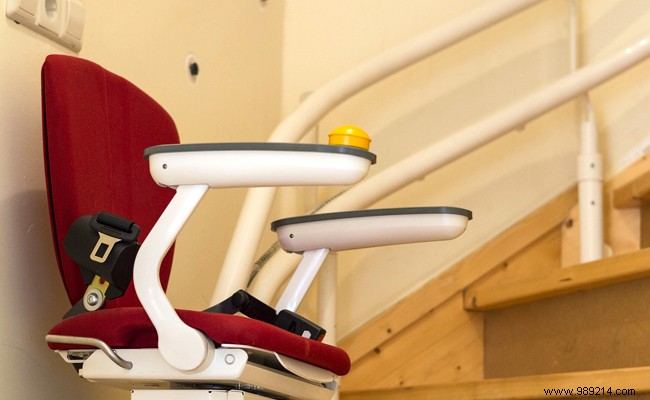With age and reduced mobility, it is often necessary to redesign homes to make them more accessible and more comfortable. Stairlifts are one of those pieces of life-changing equipment for people who find it very difficult to reach their upper floors, or even who can no longer do so without the help of a third party.
They make it possible to climb the steps of the house without any effort. The stairlift is the ideal situation to restore autonomy to an elderly person who lives at home or to disabled people by facilitating their mobility within the house. Overview of the characteristics of the different stairlifts to help you choose them better.

Stairlifts work with rails installed on the stairs depending on its shape. Depending on the manufacturers, the stairlift runs either on a single rail or on a double. A metal guide, fixed on these rails, is connected to the seat of the stairlift via a motor unit which drives a pinion on a rack. The motor works thanks to two rechargeable batteries, each placed at one end of the staircase.
A stairlift always requires fairly large available spaces at the bottom and top of the stairs. First, to facilitate its installation and use, then not to hinder the accessibility of the stairs to other users. This space is particularly necessary at the foot of the steps because a stairlift is always installed on the ground and not on the first step for reasons of accessibility and safety. As a result, it must be possible to install the stairlift seat at the bottom of the stairs without taking up all that space.
The ergonomics of the stairlift is one of the main criteria to take into account. It must indeed be particularly adapted to its user. It must also be easy to use and comfortable.
To choose a stairlift, you must first consider the physical constraints of the user. Depending on the use he can make of his legs and arms, whether or not he can adopt a sitting position, his weight, his sense of balance and the assistance he can receive home, the choice of a stairlift will be different. The seat must be well adapted and as comfortable as possible. Then, the seat control, which usually takes the form of a joystick, must correspond to the level of mobility of the user's hand.
The installation of a stairlift at home also depends on the constraints of the home. It must adapt to the width of the staircase, its shape (straight or curved), the number of floors, the spaces available at the ends of the stairs and the height of the ceiling of the stairwell.
The electric stairlift is the best known and most widespread. It is an armchair fixed on rails, themselves installed along the stairs. The controls of this stairlift are arranged both on the seat and at the top and bottom of the stairs.
The lifting chair can be installed in all houses, even on several floors. The rail is not fixed on the stairs or on the wall but on the ceiling. The seat is connected to the rail by a tube. The lifting chair has the advantage of leaving the maximum space available on the stairs. There are models suitable for wheelchairs and others for people with limited mobility. The lifting chair can accept a weight of up to 125 kilos.
This type of stairlift, which takes the form of a platform, is intended for people who use wheelchairs. They can thus, without leaving their armchair, take their place on the platform and, using controls, reach the upper floor. Some models work with rails parallel to the steps, others are more like small elevators that go up and down vertically.
The operation of this stairlift resembles real elevators in every way. It can support up to 250 kg load.
The manufacture and installation of stairlifts are governed by European and French standards intended to guarantee the safety of this equipment. These standards define the rules to be followed to avoid the risk of falls or breakdowns as much as possible.
The seat of a stairlift must meet comfort and safety standards. In particular, it can be swiveled to be as accessible as possible for the user, without effort.
The presence of obstacle detectors is mandatory on a stairlift. It automatically stops the mechanism if an object is in the way of the stairlift.
Stairlift users are all disabled and suffer from a lack of autonomy. These people are more at risk of falling. To avoid these accidents, the seat belt is mandatory on a stairlift. It allows the user to use his stairlift in complete safety.
A stairlift must be equipped with an emergency stop system in the event of abnormal operation of the mechanism or obstacles in its path.
In order to avoid any accident, the stairlift is equipped with a control system with locking. It thus prevents all persons, and in particular children, from starting up and using this equipment.
The stairlifts are all equipped with two remote controls, one installed at the bottom of the stairs, the other at the top. They make it as easy as possible to use the stairlift.
Always with the aim of securing stairlifts as much as possible, they must be equipped with a limit switch device. Its function is to automatically stop the stairlift at the end of its run, at the bottom of the stairs, as well as at the top.
The price of a stairlift varies according to many criteria such as the type of staircase, the model chosen, the options (seat covering for example) and of course the work necessary to install it at home. It is necessary to count from 3,000 euros for a classic stairlift, between 8,000 and 10,000 euros for a rotating stairlift, up to 12,000 euros for a platform or 15,000 euros for a mini-lift.